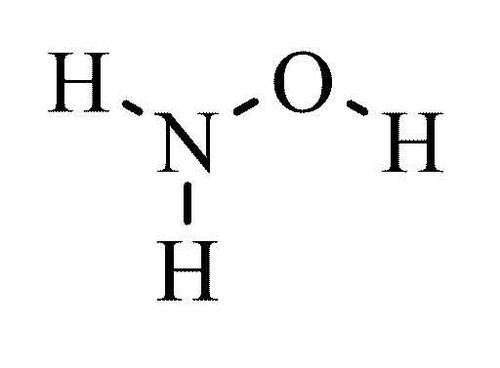3DMet B01184 Formula H3NO Density 1.21 g/cm³ Boiling point 58 °C Soluble in Water | Related compounds Molar mass 33.03 g/mol Melting point 33 °C IUPAC ID Hydroxylamine | |
 | ||
Appearance Vivid white, opaque crystals Related hydroxylammonium salts | ||
Hydroxylamine is an inorganic compound with the formula NH2OH. The pure material is a white, unstable crystalline, hygroscopic compound. However, hydroxylamine is almost always provided and used as an aqueous solution. It is used to prepare oximes, an important functional group. It is also an intermediate in biological nitrification. In biological nitrification, the oxidation of NH3 to hydroxylamine is mediated by the enzyme ammonia monooxygenase (AMO). Hydroxylamine oxidoreductase (HAO) further oxidizes hydroxylamine to nitrite.
Contents

History

Hydroxylamine was first prepared as hydroxylamine hydrochloride in 1865 by the German chemist Wilhelm Clemens Lossen (1838-1906); he reacted tin and hydrochloric acid in the presence of ethyl nitrate. It was first prepared in pure form in 1891 by the Dutch chemist Lobry de Bruyn and by the French chemist Léon Maurice Crismer (1858-1944).
Functional group

Substituted derivatives of hydroxylamine are known. If the hydroxyl hydrogen is substituted, this is called an O-hydroxylamine, if one of the amine hydrogens is substituted, this is called an N-hydroxylamine. Similarly to ordinary amines, one can distinguish primary, secondary and tertiary hydroxylamines, the latter two referring to compounds where two or three hydrogens are substituted, respectively. Examples of compounds containing a hydroxylamine functional group are N-tert-butyl-hydroxylamine or the glycosidic bond in calicheamicin. N,O-Dimethylhydroxylamine is a coupling agent, used to synthesize Weinreb amides.
Production

NH2OH can be produced via several routes. The main route is via the Raschig process: aqueous ammonium nitrite is reduced by HSO3− and SO2 at 0 °C to yield a hydroxylamido-N,N-disulfonate anion:
NH4NO2 + 2 SO2 + NH3 + H2O → 2 NH4+ + N(OH)(OSO2)22−This anion is then hydrolyzed to give (NH3OH)2SO4:
N(OH)(OSO2)22− + H2O → NH(OH)(OSO2)− + HSO4−2 NH(OH)(OSO2)− + 2 H2O → (NH3OH)
2SO
4 + SO2−
4
Solid NH2OH can be collected by treatment with liquid ammonia. Ammonium sulfate, (NH
4)
2SO
4, a side-product insoluble in liquid ammonia, is removed by filtration; the liquid ammonia is evaporated to give the desired product.
The net reaction is:
2NO−2 + 4SO
2 + 6H
2O + 6NH
3 → 4SO2−
4 + 6NH+
4 + 2NH
2OH
Hydroxylammonium salts can then be converted to hydroxylamine by neutralization:
(NH3OH)Cl + NaOBu → NH2OH + NaCl + BuOH
Julius Tafel discovered that hydroxylamine hydrochloride or sulfate salts can be produced by electrolytic reduction of nitric acid with HCl or H2SO4 respectively:
HNO3 + 3H2 → NH2OH + 2H2OHydroxylamine can also be produced by the reduction of nitrous acid or potassium nitrite with bisulfite:
HNO2 + 2 HSO3− → N(OH)(OSO2)22− + H2O → NH(OH)(OSO2)− + HSO4−NH(OH)(OSO2)− + H3O+ (100 °C/1 h) → NH3(OH)+ + HSO4−Reactions
Hydroxylamine reacts with electrophiles, such as alkylating agents, which can attach to either the oxygen or the nitrogen atoms:
R-X + NH2OH → R-ONH2 + HXR-X + NH2OH → R-NHOH + HXThe reaction of NH2OH with an aldehyde or ketone produces an oxime.
R2C=O + NH2OH∙HCl , NaOH → R2C=NOH + NaCl + H2OThis reaction is useful in the purification of ketones and aldehydes: if hydroxylamine is added to an aldehyde or ketone in solution, an oxime forms, which generally precipitates from solution; heating the precipitate with an inorganic acid then restores the original aldehyde or ketone.
Oximes, e.g., dimethylglyoxime, are also employed as ligands.
NH2OH reacts with chlorosulfonic acid to give hydroxylamine-O-sulfonic acid, a useful reagent for the synthesis of caprolactam.
HOSO2Cl + NH2OH → NH2OSO2OH + HClThe hydroxylamine-O-sulfonic acid, which should be stored at 0 °C to prevent decomposition, can be checked by iodometric titration.
Hydroxylamine (NH2OH), or hydroxylamines (R-NHOH) can be reduced to amines.
NH2OH (Zn/HCl) → NH3R-NHOH (Zn/HCl) → R-NH2Hydroxylamine explodes with heat:
4 NH2OH + O2 → 2 N2 + 6 H2OThe high reactivity comes in part from the partial isomerisation of the NH2OH structure to ammonia oxide (also known as azane oxide), with structure NH3+O−.
Uses
Hydroxylamine and its salts are commonly used as reducing agents in myriad organic and inorganic reactions. They can also act as antioxidants for fatty acids.
In the synthesis of nylon 6, cyclohexanone (1) is first converted to its oxime (2); treatment of this oxime with acid induces the Beckmann rearrangement to give caprolactam (3):
The nitrate salt, hydroxylammonium nitrate, is being researched as a rocket propellant, both in water solution as a monopropellant and in its solid form as a solid propellant.
This has also been used in the past by biologists to introduce random mutations by switching base pairs from G to A, or from C to T. This is to probe functional areas of genes to elucidate what happens if their functions are broken. Nowadays other mutagens are used. Hydroxylamine can also be used to highly selectively cleave asparaginyl-glycine peptide bonds in peptides and proteins. It also bonds to and permanently disables (poisons) heme-containing enzymes. It is used as an irreversible inhibitor of the oxygen-evolving complex of photosynthesis on account of its similar structure to water.
An alternative industrial synthesis of paracetamol developed by Hoechst–Celanese involves the conversion of ketone to a ketoxime with hydroxylamine.
Some non-chemical uses include removal of hair from animal hides and photography developing solutions. In the semiconductor industry, hydroxylamine is often a component in the "resist stripper", which removes photoresist after lithography.
Safety
Hydroxylamine may explode on heating. The nature of the explosive hazard is not well understood. At least two factories dealing in hydroxylamine have been destroyed since 1999 with loss of life. It is known, however, that ferrous and ferric iron salts accelerate the decomposition of 50% NH2OH solutions. Hydroxylamine and its derivatives are more safely handled in the form of salts.
It is an irritant to the respiratory tract, skin, eyes, and other mucous membranes. It may be absorbed through the skin, is harmful if swallowed, and is a possible mutagen.
